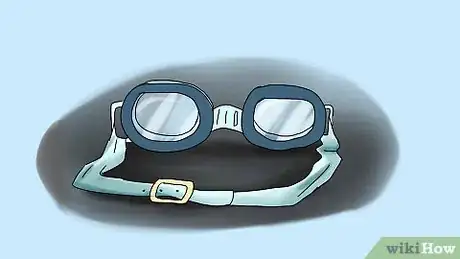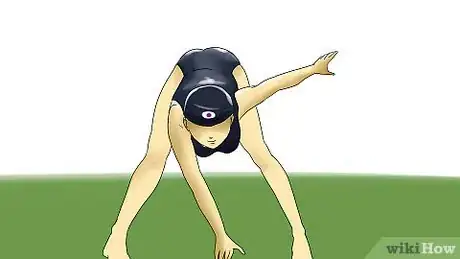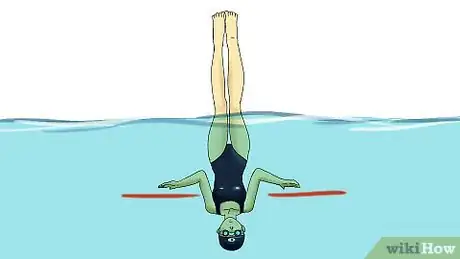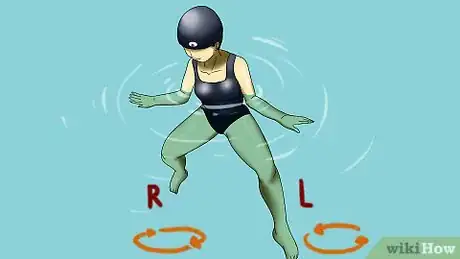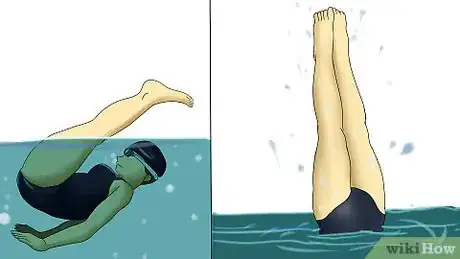X
wikiHow is a “wiki,” similar to Wikipedia, which means that many of our articles are co-written by multiple authors. To create this article, 22 people, some anonymous, worked to edit and improve it over time.
This article has been viewed 38,053 times.
Learn more...
Synchronized swimming is one of the most intricate sports in the world. Soloists, duets, trios, teams, and combos perform choreographed routines to music. Interested in this sport? Read on.
Steps
-
1Prepare. Before you even think about performing complex movements, there is a lot of work to be done. If you are not comfortable swimming in deep water, take a few swimming lessons. You do not want to be upside down and hitting your head in the shallow end, that's why a deep pool is essential.
-
2Get relatively fit, this is a good thing. Try running around the block three times a week or going on a treadmill is good. You don't have to be bodybuilder fit, but enough so you won't get tired after fifteen minutes.Advertisement
-
3Ask yourself, do you have solid core strength? Movements upside down require a surprising amount of effort from your core. Crunches and "the plank" are good things to do.
-
4Question your arm strength. Are your arms strong enough to withstand endless use? If not, using some light (no more than ten pound ones) weights is an excellent way to build up arm strength.
-
5Get flexible. Flexibility is key to synchronized swimming. You want to avoid injury as much as possible. Stretches such as lunges, pigeon, butterfly, straddle, pike position are the most influential. Synchronized swimmers often test their flexibility by using splits (left, right, and middle). Try attempting them, but don't force yourself to go flat. It takes years to get that amount of flexibility. Don't forget to stretch your arms as well.
-
6Gather your much-needed supplies essential for synchronized swimming. Here is a good list:
- A good one-piece (no bikinis) swimsuit
- 1 swim cap (some prefer silicone caps, latex caps may damage your hair, even though silicone is more expensive.)
- At least one pair of goggles, as sometimes they break.
- 1 or 2 nose plugs (You find it better to get the professional or competitive nose clips. They stay on your nose much better than the cheap plastic ones. Usually they are peachy-coloured, making them quite easy to lose.)
- 1 or 2 towels
- 1 pair of flips flops or 'Crocs' to wear on deck. (You can often pick up a virus from walking barefoot on the deck, resulting in nasty warts or infections.)
- Shampoo, conditioner, or other hair products
- 1 hairbrush
- 1 large bag to carry everything in.
-
7Start swimming. The best way to give you a good introduction to synchronized swimming is to start with a qualified coach (not just the lifeguard at the local pool). Check with your region's local synchro organization. Often they will direct you to a club or coach.
-
8If you are not able to find a coach, don't be afraid, jump in! (Not literally!)
-
9Start by stretching, as outlined above. Then, get into the pool and start swimming. You can do freestyle (front crawl), backstroke, breaststroke, fly, whatever gets you warmed up. A good rule is to stop after ten minutes.
-
10Start with the basic sculls. Headfirst scull: Lay your hands flat on the water, palms facing the bottom of the pool. They should be under your bum. Tilt your hands so your thumb is just in the water, and like a paddle push your hand outwards. Now tilt your hands so your pinkie finger is just in the water, and pull your hand back into you. Do this with both hands at the same time. To keep yourself stationary, don't point your fingers upwards, as it will make you move forwards. Sometimes, making a slight figure-eight will help people, too. You can do this scull laying on your back. This scull will work if you lay on your stomach, but scull underneath your chest, instead.
-
11Support scull: You will do this scull when you are upside down underwater. But for now, stand in the shallow end. Lay your hands in the water, palms facing upward towards the ceiling. Pull your hands towards you so that they are parallel with your side. You arms should be in a shape of an "L". Hold your hands flat and touch your pinkies together. You should feel like you are holding a tray and they are clanking together. Repeat to yourself, "in, out, in, out".
-
12Go out into deep water and do an inverted tuck, basically like a somersault position, but you are stopping halfway through. Your shins should be breaking the surface. Lean back underwater so only your legs are tucked into the somersault. Try support scull then. You should feel your shins being lifted out of the water.
-
13Do the Eggbeater: Pretend you are sitting in a chair in the shallow end. Put your shoulders back and chin up. Remember the headfirst sculling - stick your hands on either side of you, so you are making an "L" with your arms in the water and start sculling. Now the hard part. With your left leg, make a counter-clockwise circle. With your right leg, make a clock-wise circle. Keep alternating leg circles, keeping a fast pace. You are now doing eggbeater! Remember to keep sculling at the same time. This is what swimmers use to keep themselves out of the water when they are lifting their arms out of the water.
-
14Try one basic move. Lay on your back. Bend down so that your head and your feet meet. Next scull at your feet. Now push up so that your feet and your calves are in the air.
-
15Master the basic skills of synchronized swimming. Show your friends! Or better yet, keep trying to further expand your skills with a coach! You can also take a couple of tests, the swim England synchro ones are good ones to start with, you can then move onto grades.
Advertisement
Community Q&A
-
QuestionWhat kind of bathing suit do boys wear for synchronized swimming?
 Community AnswerMales often wear speedos or form fitting trunks.
Community AnswerMales often wear speedos or form fitting trunks. -
QuestionDo boys do synchronized swimmng?
 Community AnswerYes, but it is not as common and not popular enough to be an Olympic event.
Community AnswerYes, but it is not as common and not popular enough to be an Olympic event. -
QuestionIs it possible to break something while swimming?
 Community AnswerTheoretically, it would be possible to break something while swimming, but it would be pretty difficult to do.
Community AnswerTheoretically, it would be possible to break something while swimming, but it would be pretty difficult to do.
Advertisement
Warnings
- Be certain you can swim in the deep end.⧼thumbs_response⧽
- Make sure you have someone on deck watching you that knows how to swim, in case of emergency.⧼thumbs_response⧽
- Don't dive in shallow water or very deep water.⧼thumbs_response⧽
Advertisement
About This Article
Advertisement







